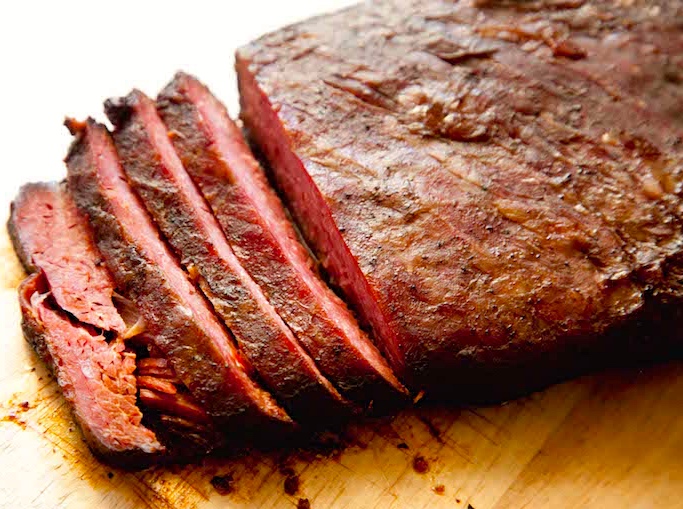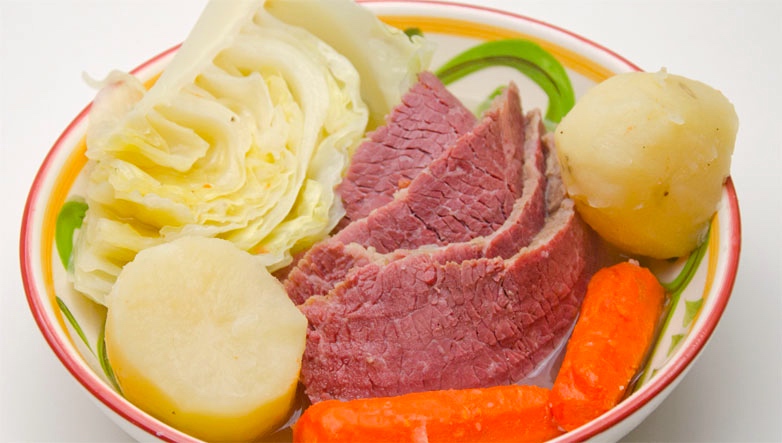On a report (from the 25th) on a recent Arby’s ad:
Arby’s Reuben Gets a New “Rachel” Variant: Arby’s latest sandwich is the new, limited-time Turkey Rachel, which is being offered as a variant on their Reuben that comes with roast turkey and housemade coleslaw rather than the corned beef and sauerkraut
To come: the sandwiches, their ingredients, their names.
The Reuben and the Rachel. From Wikipedia:
The Reuben sandwich is a hot sandwich composed of corned beef, Swiss cheese, sauerkraut, and Russian dressing, grilled between slices of rye bread. Several variants exist.
… The Rachel sandwich is a variation on the standard Reuben sandwich, substituting pastrami for the corned beef, and coleslaw for the sauerkraut. Other recipes for the Rachel call for turkey instead of corned beef or pastrami. In some parts of the United States, especially Michigan, this turkey variant is known as a “Georgia Reuben” or “California Reuben”, which sometimes uses barbecue sauce or French Dressing instead of Russian or Thousand Island.
On the dressings, see my posting of 8/13/13. Sauerkraut is mentioned briefly in my posting of of 8/24/13 and will get more coverage in a forthcoming posting on fermented food. On coleslaw (or cole slaw), see my posting of 6/14/12.
Corned beef, pastrami. Both are ways of preserving beef (or sometimes other meats).
Corned beef, from Wikipedia:
Corned beef is a salt-cured beef product. The term comes from the treatment of the meat with large grained rock salt, also called “corns” of salt. It features as an ingredient in many cuisines.
It was popular during both World Wars, when fresh meat was rationed. Corned beef remains popular in the United Kingdom and countries with British culinary traditions and is commonly used in sandwiches, corned beef hash or eaten with chips and pickles.
Corned beef:
A corned beef and cabbage dinner (with potatoes and carrots), a staple of Irish cooking in North America:
And canned corned beef:
Pastrami is more complex. From Wikipedia:
Pastrami (Turkish: pastırma, Romanian: pastramă, Bulgarian: пастърма) is a popular meat usually made from beef, and sometimes from pork, mutton or turkey. The raw meat is brined, partially dried, seasoned with various herbs and spices, then smoked and steamed. In the United States, although beef plate is the traditional cut of meat for making pastrami, it is now common to see it made from beef brisket, beef round, and turkey. Like corned beef, pastrami was originally created as a way to preserve meat before modern refrigeration.
… The modified “pastrami” spelling was probably introduced in imitation of the American English salami. Romanian Jews immigrated to New York as early as 1872. Among Jewish Romanians, goose breasts were commonly made into pastrami because they were inexpensive. Beef navels [the navel end of the brisket] were cheaper than goose meat in America, so the Romanian Jews in America adapted their recipe and began to make the cheaper beef pastrami. [See below for another account.]
… In North America, pastrami is typically sliced and served hot on rye bread to make a common New York deli sandwich (pastrami on rye), sometimes accompanied by coleslaw and Russian dressing. Pastrami and coleslaw are also combined in a Rachel sandwich
In case you were shocked by the notion of pork pastrami, here’s what Katz’s Delicatessen says:
The reason that the Lower East Side has a good claim to pastrami is quite simple. More often than not, pastrami in Romania was made with pork, and pork isn’t kosher. The Yiddish-speaking Jews of Romania knew about pastrami, but as beef was more expensive and less available in Eastern Europe than America, using beef to make pastrami would have been a real luxury. This all changed when Yiddish-speaking Jews arrived in the United States. For these immigrants, beef became affordable, at least the less favorable cuts, like navel, brisket and tongue. Even these however remained a treat. Along with expense, the prime cuts like flank, tenderloin and sirloin were not kosher because they came from the hindquarters of a cow. Of all the cuts available to these immigrants, the navel was prized the most and was used for true New York pastrami.
And a hot pastrami sandwich on rye:
The name Reuben. Wikipedia offers two origin stories, both taking the sandwich name back to the early 20th century:
(1) Reuben Kulakofsky: Omaha, Nebraska: One account holds that Reuben Kulakofsky (sometimes spelled Reubin, or the last name shortened to Kay), a Lithuanian-born grocer residing in Omaha, Nebraska, was the inventor perhaps as part of a group effort by members of Kulakofsky’s weekly poker game held in the Blackstone Hotel from around 1920 through 1935. The participants, who nicknamed themselves “the committee”, included the hotel’s owner, Charles Schimmel. The sandwich first gained local fame when Schimmel put it on the Blackstone’s lunch menu, and its fame spread when a former employee of the hotel won a national contest with the recipe. In Omaha, March 14 was proclaimed as Reuben Sandwich Day.
(2) Reuben’s Delicatessen: New York City: Another account holds that the Reuben’s creator was Arnold Reuben, the German owner of the famed yet defunct Reuben’s Delicatessen in New York City who according to an interview with Craig Claiborne invented the “Reuben special” around 1914. The earliest references in print to the sandwich are New York–based but that is not conclusive evidence, though the fact that the earliest, from a 1926 edition of Theatre Magazine, references a “Reuben special”, does seem to take its cue from Arnold Reuben’s menu.
A variation of the above account is related by Bernard Sobel in his book, Broadway Heartbeat: Memoirs of a Press Agent, which claims that the sandwich was an extemporaneous creation for Marjorie Rambeau inaugurated when the famed Broadway actress visited the Reuben’s Delicatessen one night when the cupboards were particularly bare.
Some sources name the actress in the above account as Annette Seelos, not Marjorie Rambeau, while noting that the original “Reuben special” sandwich did not contain corned beef or sauerkraut and was not grilled; still other versions give credit to Alfred Scheuing, Reuben’s chef, and say he created the sandwich for Reuben’s son, Arnold Jr., in the 1930s.
The name Rachel. So much for Reuben. Where does Rachel come from?
From the song “Reuben and Rachel”. From Wikipedia:
Reuben and Rachel is a traditional song written by Harry Birch (words) and William Gooch (melody). Originally published in Boston in 1871, the song has regained popularity as a children’s song.
The first line of the song, “Reuben, Reuben, I’ve been thinking,” was reused in the very popular song at the close of World War I (1919), “How Ya Gonna Keep ’em Down on the Farm (After They’ve Seen Paree)?.”
The song is a duet between a man and a woman. In the original version, the song begins:
Woman: Reuben, I have long been thinking,
What a good world this might be,
If the men were all transported
Far beyond the Northern Sea.Man: Rachel, I have long been thinking,
What a fine world this might be,
If we had some more young ladies
On this side the Northern Sea. …
A common version today begins:
Woman: Reuben, Reuben, I’ve been thinking
What a queer world this would be
If the men were all transported
Far beyond the Northern Sea!Man: Rachel, Rachel, I’ve been thinking
What a queer world this would be
If the girls were all transported
Far beyond the Northern Sea! …
You can listen to a performance on YouTube here.
The point is that Rachel is the counterpart of Reuben.





